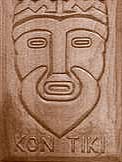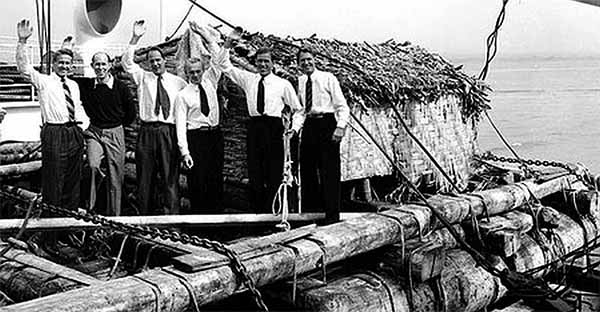Kon-Tiki Expedition : The Great Voyage of Thor Heyerdahl

The last heir of Christopher Columbus, Thor Heyerdahl, who died on April 18th 2002, will remain one of the greatest adventurers of the 20th century. On the faith of an ancient Polynesian legend, he launched himself April 28 1947 on the assault of the Pacific ocean...
Tiki
“Tiki was a god and a leader. It was Tiki who led my ancestors to these islands where we now live. We used to live in a big country beyond the seas.” Tei Tetua stops to meditate, poking the embers of his fire with dying lights. The wrinkled skin, of a bark brown, parched by the sun and the wind, Teï Tetua is the last survivor of the extinct tribes of the eastern coast of Fatu-Hiva, in the Marquesas archipelago. The scene takes place one evening in 1937, and the words of the old sage echoes strangely in the brain of the young Norwegian biologist who listens to him, fascinated. For almost a year, Thor Heyerdahl and Liv, his wife, have been living a “return to nature” experience. Only Whites in this island lost in the middle of the Pacific, they built themselves a hut on stilts in the shades of the palm trees of the shore and feed on what the tropical forest and the ocean offer them.
Tiki, the mythical ancestor, the chief god of legend, was the son of the Sun. With his people, he arrived from the west, to conquer these once deserted islands ... What if old Tei Tetua was right? Wonders Thor Heyerdahl. The large stone images, lost in the Fatu-Hiva forest, do they not evoke certain pre-Columbian monoliths? And then there is this tireless wind blowing east from the coasts of South America. This “eternal trade wind” which crosses the horizon, digs the waves, rolls them and breaks them against the rocks and reefs, before continuing always further towards the setting sun ...
Story of Kon-Tiki

The Norwegian's conjectures are transformed into certainties for him when he discovers, in a collection of Inca legends, the story of Kon-Tiki, “the sun king of white men who left huge ruins on the shore of Lake Titicaca”. This unknown race from the north would have founded a mysterious civilization in the Andes. Of high stature, wearing long beards, the companions of Kon-Tiki would have taught architecture and agriculture to the Indians, before the latter turned against them to massacre them. The survivors would then embark with their chief on the waves of the Pacific, sowing in their wake the gigantic statues of Pitcairn, Marquesas and Easter Island, and imposing staircase pyramids, like those of Tahiti and Samoas.
Needless to say, the theories of Thor Heyerdahl - albeit based on disturbing clues - hardly spark enthusiasm among scholars. Anthropologists, like the archaeologists he consults, reject his arguments with the back of the sleeve without even bothering to study them. Then came World War II, during which Thor Heyerdahl heroically fought Nazism. This did not prevent him, as soon as 1941, from publishing an article entitled "Is Polynesian culture native to America?" in the journal International Science. After the end of the conflict, the Norwegian began a tour of the United States. But it received little response from scientists. They retort him that in any case primitive ships could not have crossed the Pacific.
Thor Heyerdahl great voyage on a raft

Thor Heyerdahl therefore decides to take up the challenge. In the fifth century AD, the time when Kon-Tiki would have lived, the native americans only had balsa wood rafts. Never mind ! It is aboard a boat of this type that he claims to rally the Marquesas or the Tuamotus from the coast of South America! A race of more than 8,000 km! However, thanks to the constancy of the sea currents, Thor Heyerdahl is confident that he will reach his goal without deviating ...
Thus, on April 28, 1947, six risers, and a parrot, cast off the moorings in the Peruvian port of Callao. Their “ship” is made up of nine large balsa trunks, recovered from the jungle of Ecuador, tied by hemp ropes. It is only ten meters in length. Towards the middle of the bridge stands a small bamboo cabin with a roof covered with banana leaves. The yard where the mainsail is hoisted consists of two bamboo canes linked together. Four Norwegians have agreed to help their compatriot meet his reckless challenge. Engineer Herman Watzinger will be second to Thor Heyerdahl. It is responsible for hydrographic and meteorological observations. Knut Haugland and Torstein Raaby, war heroes, former resistance fighters, are TSF aces. Erik Hesselberg is the only true sailor on board. He is also distinguished by his talents as a designer and a guitarist. The sixth friend, Bengt Danielsson, a prominent ethnologist, is the only Swede in the group. He takes away a library of 73 sociology works, but he will also act as chef. He will become a master in the art of capturing flying fish. As for Thor Heyerdahl, the captain of this expedition, he admits that he suffered for a long time from ... the phobia of water! As a child, he almost drowned in a frozen lake. He only learned to swim at the age of 22 in Polynesia, and declared himself incapable of crossing the Oslo fjord by sail! Such is the extravagant crew of the Kon-Tiki. Because, in homage to the “son of the Sun”, Thor Heyerdahl baptized his skiff thus. And the mainsail, inflated by the trade wind, sports the face of the bearded god of legend ...
According to the forecasts of Thor Heyerdahl, the crossing proceeds without notable difficulties. For almost three months, the passengers of Kon-Tiki will only have the spectacle of the ocean, to the extreme limits of infinity: “The blue of the sea merged with the blue of the sky, and we sometimes had the impression of being suspended in space; our whole universe was empty and blue; there was no landmark except the tropical sun, warm and golden, which burned our necks. ” Each of the six men takes the helm two hours a day, and another two hours at night. The rest of the time is free. Both go about their respective occupations. Throughout the course, the fishing proves to be miraculous and the supplies on board largely sufficient. Invariably, the east wind pushes Kon-Tiki towards its destination. And even at the height of storms, the most impressive waves will never manage to unbalance the raft. Finally, on July 30, a land appears in the distance. It is the island of Puka-Puka, belonging to the Tuamotu archipelago. The coral reef does not allow you to enter the lagoon. Thor Heyerdahl and his companions continue on their way. A week later, after one hundred and one days at sea, after crossing 4,300 nautical miles, the Kon-Tiki crashed on the reefs of the Raroïa atoll. Despite some damage, the solid raft resisted. And its passengers, their faces chiselled by the sun and the spray, escaped without damage. “When I reached the sunny beach, remembers Thor Heyerdahl, I took off my shoes and plunged my bare toes into the warm, dry sand. The sight of each of my footprints on this pristine beach that went up to the forest caused me great pleasure. ”
A few weeks later, the six Scandinavians joined Tahiti, aboard the Tamara, sent to search for them by the French governor. Thus ended, by an indisputable success, the team of Kon-Tiki. But Thor Heyerdahl had shown nothing, except his own courage and determination. Part of the scientific community will continue to accuse him of being an illusionist and an adventurer. Some will even dare to speak of deception. However, popular recognition will crown the Norwegian's efforts. His book, The Kon-Tiki Expedition, will be translated into over fifty languages and sold millions of copies. In 1952, the documentary made with an amateur camera during the crossing will receive the Oscar for best documentary in Hollywood. As for the valiant Kon-Tiki, brought back from Polynesia, it is today exhibited in an Oslo museum dedicated to it, testimony to the fact that the wildest dreams can sometimes come true.









































































































































































































































































































































